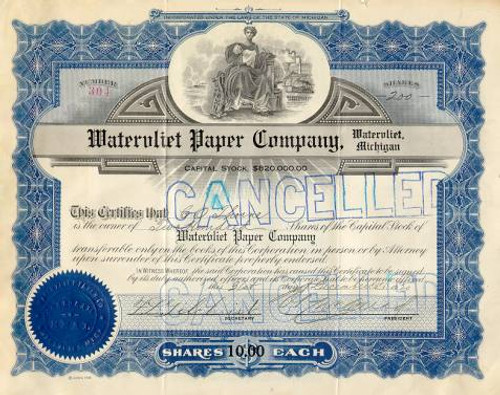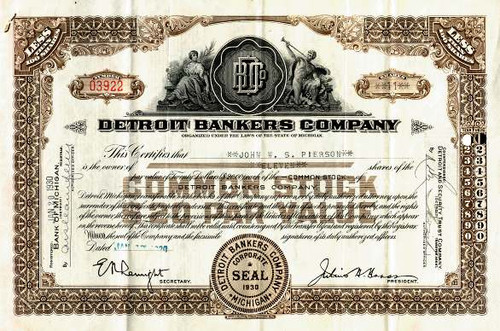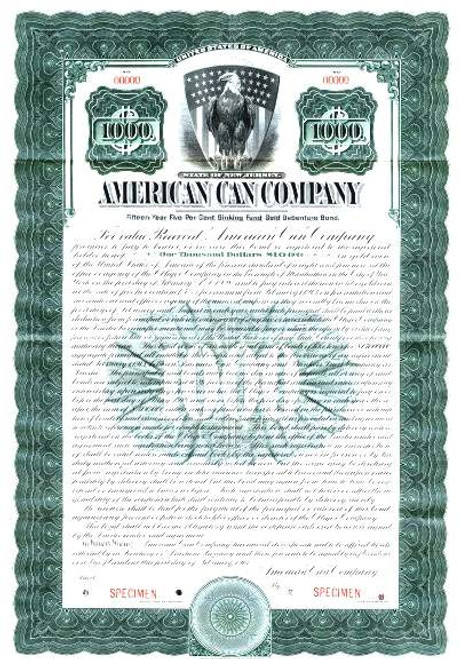Beautifully engraved Bond Certificate from the famous D. H. Baldwin Company issued in 1982 at 15 %. This historic document was printed by the American Banknote Company and has a green ornate border around it with a picture of the founder, Dwight Hamilton Baldwin in the center. 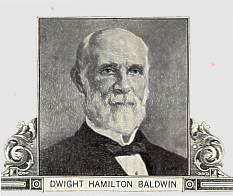
Certificate Vignette In 1862, reed organ and violin teacher Dwight Hamilton Baldwin opened the doors to his music store in Cincinnati, Ohio. During the next quarter century, Baldwin became one of the largest piano retailers in the Midwestern United States. With an eye on increased growth opportunities, Baldwin decided to manufacture "the best piano that could be built" in 1890. The first Baldwin piano, an upright model, was available one year later. In 1895, the company introduced its first grand piano, a 5'4" model. 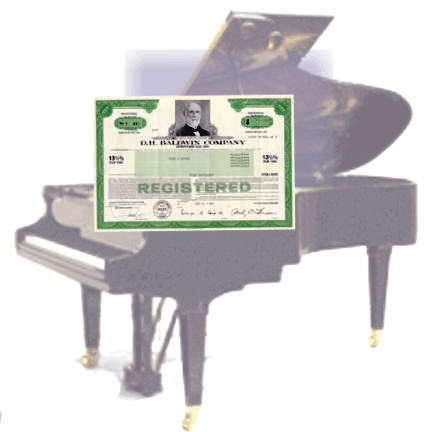
The following is the history of the famous D.H. Baldwin company: 1821 Dwight Hamilton Baldwin is born in Erie County, Pa. 1862 Baldwin establishes a retail piano and organ business in Cincinnati, Ohio. 1873 Lucien Wulsin, a bookeeper with the company since 1866, enters into a partnership with Dwight Baldwin 1891 Designed by Baldwin piano technician and inventor John Warren Macy, the first Baldwin-built vertical piano is offered at the firm's Cincinnati store. 1891 Baldwin purchases a brick building on Gilbert Avenue in Cincinnati. This location is subsequently expanded to become the company's manufacturing and corporate headquarters. 1895 The first Baldwin grand piano (scale G, 5'4" in length), designed by John Macy, is introduced. 1899 D.H. Baldwin dies. 1900 A Baldwin grand is awarded the Grand Prix at the Paris Exhibition. As a result, Baldwin joins a very limited group of manufacturers supplying concert grands for performing artists. 1901 Lucien Wulsin becomes the first president of Baldwin. 1905 Baldwin player piano production begins. 1913 Baldwin exports pianos to 32 countries around the globe. 1914 A Baldwin piano earns the grand prize at the Anglo-American Exposition in London. 1923 Player piano market peaks at 56 percent of the industry's total piano production. 1924 Mrs. Calvin Coolidge selects a Baldwin piano for the White House. 1926 Lucien Wulsin II, the son of Lucien Wulsin, is named president of Baldwin. 1929 More than 220 radio stations nationwide prefer the Baldwin piano's tone quality for broadcasting. 1931 The Great Depression results in declined piano production. Only 51,000 instruments are manufactured this year by the entire industry. 1935 Baldwin experiments with the creation of electronic musical tones. This leads to the development of the Baldwin electronic church organ. 1936 Baldwin Acrosonic vertical piano is introduced. 1939 Baldwin Hamilton studio piano is unveiled. 1942 During World War II, Baldwin factories produce military aircraft subassemblies. Lessons learned in the construction of wooden aircraft wings ultimately enhance Baldwin's laminated pinblock designs. 1945 Composer Aaron Copland becomes a Baldwin Artist. 1945 Pianist Liberace becomes a Baldwin Artist. 1946 The first Baldwin electronic organ is introduced. 1952 President Harry Truman plays a Baldwin piano during the first televised tour of the White House. 1956 Baldwin receives a patent for its 41-Ply Pinblock design, which offers exceptional tuning stability. 1961 Lucien Wulsin III is named president of Baldwin. 1962 Two American space flights are guided by electronic encoders developed in Baldwin research laboratories. 1962 Greenwood, Miss., plant opens to craft cabinets for both pianos and organs. 1965 Baldwin begins production of vertical pianos at Conway, Ark., facility. 1965 The 9-foot Baldwin SD10 Concert Grand is unveiled and heralded as the first major advancement in piano design in decades.. 1967 Grand piano production begins at Conway, Ark., plant. 1969 Baldwin receives a patent for its Acu-JustTM Hitch Pin design, which results in improved tonal resonance. 1971 The Baldwin home electro-piano is introduced. 1973 One millionth Baldwin vertical piano is built. 1973 The New York Stock Exchange opens trading of D.H. Baldwin common shares. 1974 Dick Harrison, who joined the company in 1955 as assistant treasurer, is named president. 1974 The Baldwin FunMachine, a popular easy-to-play electronic keyboard, is introduced. 1980 Production of vertical pianos begins at Baldwin's Trumann, Ark., piano facility. 1984 The Baldwin Model 6000 Concert Vertical piano (52" in height) is unveiled. 1984 Baldwin senior management acquires the Company from Baldwin-United Corporation. 1986 After being privately held by senior management, an initial public stock offering is made. Shares are listed on the NASDAQ National Market. (Symbol: BPAO) 1988 Baldwin purchases the keyboard division of The Wurlitzer Company. 1994 Karen Hendricks, previously with Dial Corp. and The Procter & Gamble Company, succeeds Dick Harrison as Baldwin president and CEO. 1995 The Chickering name is reintroduced to consumers on new grand piano models manufactured by Baldwin. 1995 The Baldwin PianovelleTM digital piano product line is introduced. 1997 The Baldwin ConcertMasterTM, a computerized player piano system, is introduced on Baldwin, Chickering and Wurlitzer pianos. May 30, 2001 20:42 Baldwin Piano & Organ Co. Announces Intent to Reorganize Under Chapter 11 of The United States Bankruptcy Code MASON, Ohio, May 30 -- Baldwin Piano & Organ Company today announced its intent to file for bankruptcy protection under Chapter 11 of the United States Bankruptcy Code. Previously, the Company announced on April 24, 2001, a liquidity squeeze that was having a negative impact on the Company. Subsequently, Baldwin hired Robert Jones as the new chief executive officer and announced that Kenneth W. Pavia was elected chairman of the board of directors. In a statement, Pavia said that while he had full confidence in Jones and his ability to return the Company to profitability, the liquidity squeeze coupled with certain legacy issues made the operation of Baldwin, as presently defined, virtually impossible. Pavia commented, "The legacy of past management makes the day-to-day operations of our core business impossible. Disproportionate severance agreements, excessive inventory, excess administrative expenses in relation to historical Company performance, internal control issues, executive compensation arrangements that seem to exceed reasonable standards, and an extensive list of substantial payables are some examples of the factors we can not overcome." "Other factors that led to our decision to file for protection," Pavia added, "included unduly burdensome lease arrangements entered into under past administrations, restrictive borrowing arrangements with our lender, and the inability to secure concessions in regard to our liquidity crisis." "The dealers, factory personnel, and the new management deserve the opportunity to bring Baldwin back to its glory without the added pressure of past mismanagement," Pavia emphasized. "All attempts to resolve this matter informally were explored and given due consideration. Unfortunately, the pressures caused by the lack of liquidity and the demand of our creditors, including prior management's demand for the immediate payment under certain change of control agreements, made any recovery impossible. In the end, for the benefit of all concerned, including our shareholders, a formal, orderly reorganization became the only viable alternative." In a statement, Jones said that he looked forward to leading the Company out of bankruptcy and working diligently to restore the Baldwin name and maintain the Company's relationship with its dealers and customers. He continued, "Despite being CEO for only three weeks, I am convinced that the personnel at our factories have the ability, desire, and loyalty to make quality pianos and achieve enhanced values. I firmly believe that the Baldwin name stands for our loyal employees and dealers. With their continued support and the implementation of our strategic plan, Baldwin can return to profitability within a relatively short period." Baldwin Piano & Organ Company, the maker of America's best selling pianos, has marketed keyboard musical products for over 140 years.

Certificate Vignette

The following is the history of the famous D.H. Baldwin company: 1821 Dwight Hamilton Baldwin is born in Erie County, Pa. 1862 Baldwin establishes a retail piano and organ business in Cincinnati, Ohio. 1873 Lucien Wulsin, a bookeeper with the company since 1866, enters into a partnership with Dwight Baldwin 1891 Designed by Baldwin piano technician and inventor John Warren Macy, the first Baldwin-built vertical piano is offered at the firm's Cincinnati store. 1891 Baldwin purchases a brick building on Gilbert Avenue in Cincinnati. This location is subsequently expanded to become the company's manufacturing and corporate headquarters. 1895 The first Baldwin grand piano (scale G, 5'4" in length), designed by John Macy, is introduced. 1899 D.H. Baldwin dies. 1900 A Baldwin grand is awarded the Grand Prix at the Paris Exhibition. As a result, Baldwin joins a very limited group of manufacturers supplying concert grands for performing artists. 1901 Lucien Wulsin becomes the first president of Baldwin. 1905 Baldwin player piano production begins. 1913 Baldwin exports pianos to 32 countries around the globe. 1914 A Baldwin piano earns the grand prize at the Anglo-American Exposition in London. 1923 Player piano market peaks at 56 percent of the industry's total piano production. 1924 Mrs. Calvin Coolidge selects a Baldwin piano for the White House. 1926 Lucien Wulsin II, the son of Lucien Wulsin, is named president of Baldwin. 1929 More than 220 radio stations nationwide prefer the Baldwin piano's tone quality for broadcasting. 1931 The Great Depression results in declined piano production. Only 51,000 instruments are manufactured this year by the entire industry. 1935 Baldwin experiments with the creation of electronic musical tones. This leads to the development of the Baldwin electronic church organ. 1936 Baldwin Acrosonic vertical piano is introduced. 1939 Baldwin Hamilton studio piano is unveiled. 1942 During World War II, Baldwin factories produce military aircraft subassemblies. Lessons learned in the construction of wooden aircraft wings ultimately enhance Baldwin's laminated pinblock designs. 1945 Composer Aaron Copland becomes a Baldwin Artist. 1945 Pianist Liberace becomes a Baldwin Artist. 1946 The first Baldwin electronic organ is introduced. 1952 President Harry Truman plays a Baldwin piano during the first televised tour of the White House. 1956 Baldwin receives a patent for its 41-Ply Pinblock design, which offers exceptional tuning stability. 1961 Lucien Wulsin III is named president of Baldwin. 1962 Two American space flights are guided by electronic encoders developed in Baldwin research laboratories. 1962 Greenwood, Miss., plant opens to craft cabinets for both pianos and organs. 1965 Baldwin begins production of vertical pianos at Conway, Ark., facility. 1965 The 9-foot Baldwin SD10 Concert Grand is unveiled and heralded as the first major advancement in piano design in decades.. 1967 Grand piano production begins at Conway, Ark., plant. 1969 Baldwin receives a patent for its Acu-JustTM Hitch Pin design, which results in improved tonal resonance. 1971 The Baldwin home electro-piano is introduced. 1973 One millionth Baldwin vertical piano is built. 1973 The New York Stock Exchange opens trading of D.H. Baldwin common shares. 1974 Dick Harrison, who joined the company in 1955 as assistant treasurer, is named president. 1974 The Baldwin FunMachine, a popular easy-to-play electronic keyboard, is introduced. 1980 Production of vertical pianos begins at Baldwin's Trumann, Ark., piano facility. 1984 The Baldwin Model 6000 Concert Vertical piano (52" in height) is unveiled. 1984 Baldwin senior management acquires the Company from Baldwin-United Corporation. 1986 After being privately held by senior management, an initial public stock offering is made. Shares are listed on the NASDAQ National Market. (Symbol: BPAO) 1988 Baldwin purchases the keyboard division of The Wurlitzer Company. 1994 Karen Hendricks, previously with Dial Corp. and The Procter & Gamble Company, succeeds Dick Harrison as Baldwin president and CEO. 1995 The Chickering name is reintroduced to consumers on new grand piano models manufactured by Baldwin. 1995 The Baldwin PianovelleTM digital piano product line is introduced. 1997 The Baldwin ConcertMasterTM, a computerized player piano system, is introduced on Baldwin, Chickering and Wurlitzer pianos. May 30, 2001 20:42 Baldwin Piano & Organ Co. Announces Intent to Reorganize Under Chapter 11 of The United States Bankruptcy Code MASON, Ohio, May 30 -- Baldwin Piano & Organ Company today announced its intent to file for bankruptcy protection under Chapter 11 of the United States Bankruptcy Code. Previously, the Company announced on April 24, 2001, a liquidity squeeze that was having a negative impact on the Company. Subsequently, Baldwin hired Robert Jones as the new chief executive officer and announced that Kenneth W. Pavia was elected chairman of the board of directors. In a statement, Pavia said that while he had full confidence in Jones and his ability to return the Company to profitability, the liquidity squeeze coupled with certain legacy issues made the operation of Baldwin, as presently defined, virtually impossible. Pavia commented, "The legacy of past management makes the day-to-day operations of our core business impossible. Disproportionate severance agreements, excessive inventory, excess administrative expenses in relation to historical Company performance, internal control issues, executive compensation arrangements that seem to exceed reasonable standards, and an extensive list of substantial payables are some examples of the factors we can not overcome." "Other factors that led to our decision to file for protection," Pavia added, "included unduly burdensome lease arrangements entered into under past administrations, restrictive borrowing arrangements with our lender, and the inability to secure concessions in regard to our liquidity crisis." "The dealers, factory personnel, and the new management deserve the opportunity to bring Baldwin back to its glory without the added pressure of past mismanagement," Pavia emphasized. "All attempts to resolve this matter informally were explored and given due consideration. Unfortunately, the pressures caused by the lack of liquidity and the demand of our creditors, including prior management's demand for the immediate payment under certain change of control agreements, made any recovery impossible. In the end, for the benefit of all concerned, including our shareholders, a formal, orderly reorganization became the only viable alternative." In a statement, Jones said that he looked forward to leading the Company out of bankruptcy and working diligently to restore the Baldwin name and maintain the Company's relationship with its dealers and customers. He continued, "Despite being CEO for only three weeks, I am convinced that the personnel at our factories have the ability, desire, and loyalty to make quality pianos and achieve enhanced values. I firmly believe that the Baldwin name stands for our loyal employees and dealers. With their continued support and the implementation of our strategic plan, Baldwin can return to profitability within a relatively short period." Baldwin Piano & Organ Company, the maker of America's best selling pianos, has marketed keyboard musical products for over 140 years.




